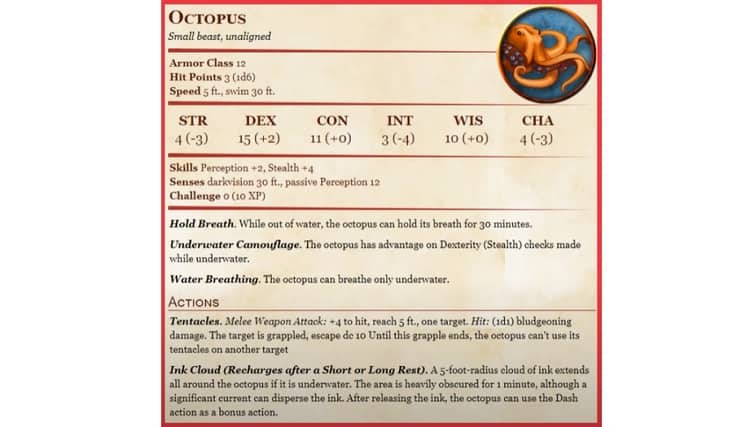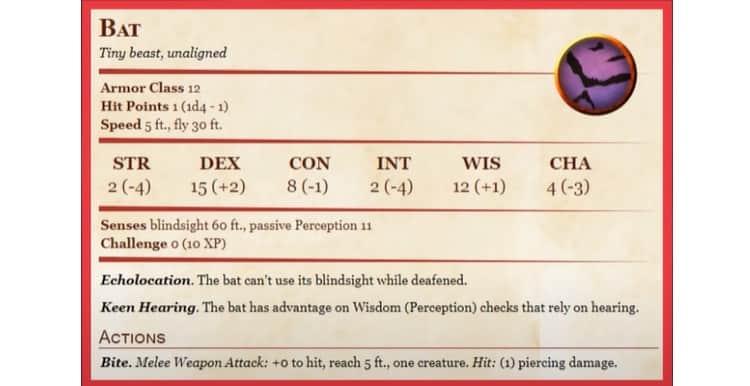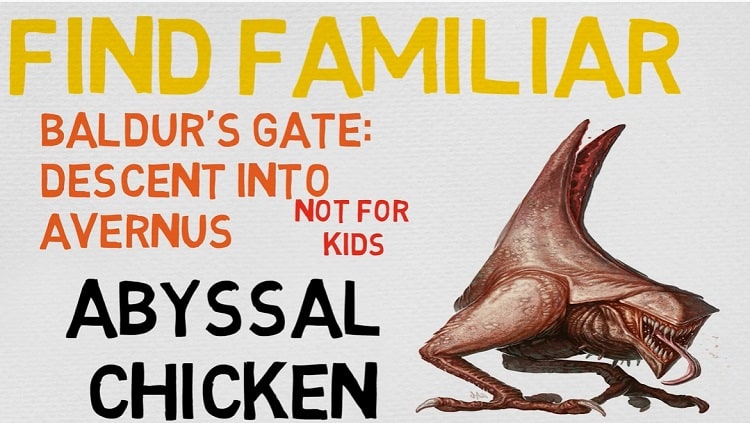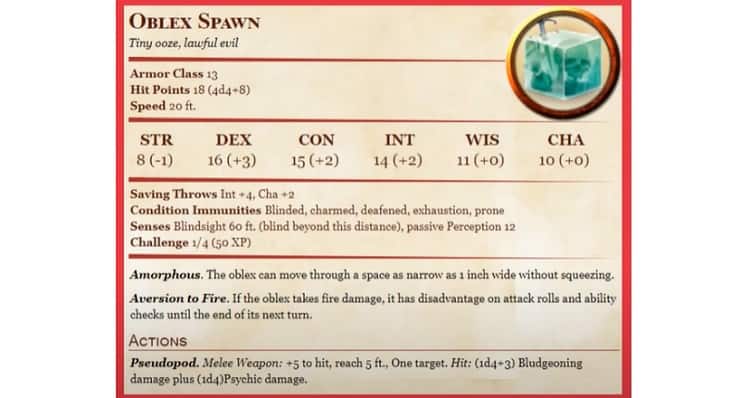The spell featured in this Find Familiar 5e Guide is one of the best low-level spells in D&D. By casting it, you gain a spirit animal known as a familiar. While your familiar is not effective at attacking, there are many effective uses that can transform your character from occasionally effective to outstandingly potent.
What is the Find Familiar Spell?
Find Familiar is a 1st level conjuration (ritual) spell on the wizard spell list. It takes one hour to cast and requires you to have charcoal, incense, and herbs worth 10 gold pieces.
When you cast the spell, you set these materials in a brass brazier and set them on fire. The spell also requires verbal and somatic components, which should be easily provided in that hour.
Once you have finished the spell, a spirit in the form of an animal appears within 10 feet of you, presumably in the Brazilian after the fire consumes the components. The spell describes how you can use your familiar:
- Your familiar looks like an animal but you choose whether it is a celestial creature, fey, or fiend.
- It rolls its own initiative and acts on its own turn, but obeys you completely.
- It cannot attack but can take any other action. This includes taking the Dash, Dodge, Disengage, Help, or Hide action.
- The spell itself does not determine how long your familiar lasts. Rather, the spell is responsible for bringing the familiar to you. Once it’s here, it lasts indefinitely.
- You can communicate with it telepathically while within 100 feet. You can also see and hear through it for six seconds while being blind and deaf to your own senses.
- You can dismiss it temporarily or permanently. When you dismiss it temporarily, it is felt to be a cozy pocket dimension waiting for you to bring it back. If you dismiss it permanently, you must cast the spell again to bring it back.
- You can’t have more than one family member at a time. If you cast this spell while you already have a familiar, your current familiar can adopt a new form.
- When you cast a spell with a range of touch, your familiar can deliver the spell as if it had cast it. This only works while your family is within 100 feet of you.
Because of its long casting time, the spell is not designed to be cast in combat. Rather, it is a preparatory spell cast in your downtime, perhaps at the end of a long day with a leftover spell slot.
What Can a Familiar Do?

Help
The spell specifies that your familiar cannot attack, but it can take other actions. By far, the most helpful action is fittingly the Help action. This action can be found on page 192 of the Player’s Handbook.
The Help action can be used to aid another creature to give advantage on their next ability to check to perform the task you are helping with. It can instead give a creature advantage on their next attack against a creature within 5 feet of you.
Send your familiar into battle and place them within 5 feet of the enemy you plan to attack. Your familiar begins to distract your enemy and gives you advantage on your next attack roll against that enemy.
If you’re planning on casting a spell that instead requires a saving throw, you can move your family member to give Help action to another member of your party.
For example, you could send it to help the rogue so that they can always deal sneak attack damage. Regardless, the familiar provides a consistent source of advantage on the battlefield for your party.
Continue reading this guide to learn more about Help Action in 5e.
Scouting
Secondly, your familiar is a great scouting option for your entire adventuring party. If you aren’t sure what’s in the next room, what’s making that sound in the forest, or what the people in the back of the bar are talking about, you can send your family member to retrieve the necessary information.
Since your familiar looks like an animal, many people will not pay them any attention. Add creatures in the wild might not even notice them at all. Since you communicate telepathically with it, it can tell you everything that it saw or heard once it’s within range again.
Which Animals Can be Familiar?

When you cast the spell, you choose what animal form it takes. Your familiar will assume the statistics of whatever animal you take, so there are functional differences to your choice.
You should also consider your character’s personality and which animal will bond well with them. Conversely, you might find it amusing to pick an animal completely opposite in nature to your character.
Classic Family
The spell describes the animal options for familiars. The following is a breakdown of their mechanical benefits. Since your familiar can’t attack, the useful statistics are their skills, movement, and any special abilities.
- Bat. Blindsight, flight, and advantage hearing checks.
- Cat. Advantage on smell checks is situational at best but a 40ft speed gets them where they need to be to give the Help action.
- Crab Crabs are pretty slow and don’t offer much else.
- Frog (toad). Same as the crab but with a slightly better perception.
- Hawk. 60ft flight speed and advantage on checks that rely on sight make hawks great anywhere except for a dark dungeon.
- Lizard Same as the crab but with a climb speed instead of a swim speed.
- Octopus. Only good in an underwater campaign. It is adept at moving stealthily, making it a good underwater scout.
- Owl. Flight, superior darkvision, and advantage on sight- and hearing-based perception makes for a great scout. It’s easy to overlook the flyby ability. They don’t provoke opportunity attacks when flying away. You can safely send them in to take the help action then get them out of the way.
- Poisonous Snake. Since familiars can’t attack, you don’t benefit from the poison damage they normally deal.
- Fish (quipper). Only good underwater, but with a poor perception, they make awful scouts.
- Rat. Darkvision and advantage on smell checks.
- Raven. Flight and a decent perception. You won’t really need the mimicry ability since you can communicate telepathically with it.
- Sea Horse. Only good underwater and not good for much else.
- Spider. Decent stealth and they can climb on ceilings. You could technically locate an invisible creature by casting Web and sending your spider in.
- Weasel. Decent perception and stealth, and advantage on hearing and smelling checks.
Overall, the best option is the owl. They can scout in any environment (except underwater) and don’t provoke opportunity attacks, reducing the number of times you need to cast the spell to bring them back. The best underwater option is the octopus with great stealth and scouting abilities.
family variants

In addition to the animals listed in the spell’s description, additional creatures have been added to the game from various sourcebooks accompanied by a note saying that with the DM’s permission, the creature could be the form of your familiar.
- Abyssal Chicken (Descent Into Avernus). The chicken-like creature native to the abyss, this creature can fly but falls at the end of every turn. It is much more durable than normal options with 10 hit points, resistant to cold, fire, and lightning damage, and immune to poison damage.
- Almiraj (Tomb of Annihilation). This is a bunny with a unicorn horn. It’s adorable. It also has decent perception and stealth, at 50ft speed, and advantage on sight and hearing checks.
- Anvilwrought Raptor (MOoT). This creature is a constructed metal bird. With 18 hit points and immunity to many conditions, fire, and poison damage, this thing is hard for enemies to take down. It also has advantage on sight checks and can record people.
- Flying Monkey (Tomb of Annihilation). Flight is useful. Pack tactics aren’t as useful when the monkey’s not the one attacking.
- Gazer (VGtM). Ever wanted a pet beholder? These are basically baby beholders.
- Imp (MM). A tiny devil that can turn invisible and can share its magic resistance with you.
- Quasit (MM). A shape-changing demon with many damage resistances and can share its magic resistance with you.
- Tressym (Storm King’s Thunder). What’s better than a cat? A cat with wings! This creature can also see invisible creatures within 60 feet of it.
- Pseudodragon (MM). A tiny dragon with keen perception and magic resistance that it can share with you.
Beyond the scope of the named creatures that can function as familiar, note on page 347 of the Monster Manual claims that NPC spellcasters can have any Tiny monster as familiar. While this isn’t for PCs, you can use this block of text to justify gaining a velociraptor as a familiar. Be warned that if you do, your DM will make an enemy with a Demilich as their family out of spite.
Homebrew Family
What about a beetle? The squirrel? The jackrabbit? You might have a specific idea of what kind of animal you want your character to have. Most DMs are willing to accommodate this as long as it’s not an incredibly overpowered animal.
You might be able to easily reskin an existing option into what you want like the familiar bald eagle who uses the hawk stat block. Or you might work with your DM to create your own familiar statistics. As long as they approve of the final product, you can play it!
Who Can Access the Spell?

Have I won you over that this is a great spell? Good! But it’s only on the wizard spell list. Do you have to be a wizard in order to gain a familiar?Not at all. There are many ways to get what you want in D&D. Here are some ways to access this spell.
- Bard’s Magical Secrets ability gives them access to any spell in the game. Lore bards gain this at 6th level.
- Druids can spend a use of Wildshape to cast this spell using the optional druid feature Wild Companion.
- The fighter subclass Eldritch Knight gains three wizard spells at 3rd level, one of which can be from any school.
- Similarly, the rogue subclass Arcane Trickster gains three wizards spells at 3rd level, one of which can be from any school.
- Pact of the Tome warlocks gain access to ritual spells.
- Pact of the Chain warlocks revolve around knowing this spell.
- Any character with at least 13 in either Intelligence or Wisdom can take the Ritual Caster feat.
- Any character can take the Magic Initiate feat and choose this spell as their 1st level spell option.
- Similarly, magical spell-storing items like a Reserve Ioun Stone or a Ring of Spell-Storing can have the spell cast into it and then given to someone else to use.
Pact of the Chain: Super Familiars

Pact of the Chain warlocks Learn the Find Familiar spell at 3rd level. However, this version of the spell has some benefits built into it, with additional upgrades available as Eldritch Invocations.
When you cast this spell, you can choose one of the following additional options as its form:
- Tax See Family Variant above.
- Pseudodragon. See Family Variant above.
- Almost. See Family Variant above.
- Sprite. A tiny fey creature, sprites can turn invisible, have good perception and exceptional stealth.
You can also sacrifice your attack to have your familiar use their reaction to attack. While most of the time, you’ll be more effective, you’ll be able to use some unique abilities from the quasit’s Scare ability to the Gazer’s eye beams.
As you level up as a warlock class, you gain access to Eldritch Invocations. Some of these invocations make your family even more effective.
- Voice of the Chain Master (PHB) . Your telepathy and ability to perceive through your familiar’s senses are unlimited as long as you’re both on the same plane. In addition, you can speak through your family. Now you can scout ahead and negotiate without ever being in harm’s way.
- Gift of the Ever-Loving Ones (XGtE) . Every time you regain hit points within 100 feet of your familiar, you regain the maximum healing. This includes healing spells and potions as you’d expect but it also includes recovering using hit dice.
- Investment of the Chain Master (TCoE) . You grant your familiar to flight or swim speed, you can command it to attack the bonus action, your familiar’s attacks become magical, your familiar uses your spell save DC, and you can use your reaction to grant your familiar resistance to incoming damage.
The last option is by far the best option and turns your familiar from a source of advantage into another capable member of your adventuring party. As you level up as a warlock, you can gain all of these abilities.
Delivering Touch Spells

The last ability of the familiar is that when you cast a spell with a range of touch, you can cast it through your familiar. This means that you can send your familiar in to deliver a spell for you without having to get close to the battle yourself.
You’ll find this is most useful to provide buffing spells to your allies who are already engaged in combat with enemies. Send your familiar in to heal using Cure Wounds , buff using Heroism , or add utility with Fly.
FAQ
Question: What is the Best Way to Use Find Familiar 5e?
Answer: The two best uses of your family are to give the Help action to gain advantage to someone every round on an attack roll and to scout ahead of the party without risking an ambush on a party member.
Question: How Does Find Familiar Work?
Answer: The spell takes to cast an hour and Gives you obeys the spirit animals That you and exists until it drops to 0 HP.
Question: What Classes Can Get Familiar Find ?
Answer: Any class can get Find Family through the Magic Initiate or Ritual Caster feat or through the spell storing that item has cast the spell into it. Otherwise, bards, druids, eldritch knights, arcane tricksters, warlocks, and wizards can also
Question: What is the Best Family 5e?
Answer: The owl is the best option listed in the spell with darkvision, flight, and flyby.
Question: Can You Polymorph to Familiar?
Answer: Yes, but it still won’t be able to attack.
Question: Can a Sorcerer Have a Familiar 5e?
Answer: Yes, sorcerers can access a familiar through the Magic Initiate Feat or Ritual Caster feat.
Question: Does a Familiar Count as a Creature?
Answer: Yes, your familiar is a celestial, fey, or fiend, which are all creatures. Any effect that would affect the creature would affect the familiar.
Question: Does it Take an Action to Command a Familiar?
Answer: No, commanding it to Help or taking other actions does not require an action..
Summary
Gaining a familiar to help you for scouting and combat in D&D is an incredibly powerful character option. Since it’s only a 1st level spell, there are many different ways to gain access to it without being a wizard.
Your familiar is a constant source of advantage on attacks and gives you a companion to enhance your character’s aesthetic. If you can get this spell, it’s a good idea to do it. Even if your familiar drops to 0 HP, you’re only 1 hour and 10gp away from having your friend back
- Armor of Agathys 5e Guide: What is Armor of Agathys? - August 3, 2022
- Oath of the Ancients 5e Guide - August 3, 2022
- Dissonant Whispers 5e Guide - July 20, 2022

